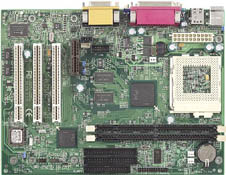Supermicro 370SWD i810 microATX Socket-370
by Mike Andrawes on August 14, 1999 11:28 PM EST- Posted in
- Motherboards
As a high end server/workstation motherboard manufacturer, we've seen Supermicro's expertise spill over into the low end market with the Socket-370 i440BX Supermicro 370SBA. Now presented with the i810, Supermicro faces an even greater challenger with an even greater focus on cost reduction The Supermicro 370SWD is the result and follows in typical Supermicro fashion.
New Anand Tech Report Card Rating 87/B
| CPU Interface | Socket-370 |
| Chipset | Intel i810 |
| L2 Cache | N/A (on-chip) |
| Form Factor | microATX |
| Bus Speeds | 66
/ 72 / 100 / 107 112 / 117 / 125 / 133 |
| Clock Multipliers | 2.0x - 8.0x |
| Voltages Supported | Auto Detect |
| Memory Slots | 2 168pin DIMM Slots |
| Expansion Slots |
1 AMR Slot |
| BIOS | AMI BIOS HiFlex 1.18 |
The Good
At first glance, it appears that he Supermicro 370SWD is pretty much a standard i810 board with a Socket-370 CPU interface. The 3/1/0/0 (PCI/AMR/ISA/AGP) slot configuration is typical for a microATX i810 board. All slots can handle a full length board if necessary thanks to the placement of the front panel headers out of the way of the expansion slots. Two DIMM slots, the maximum for an i810 board, round out the expansion options.
Handling I/O duties for the 370SWD is Intel's 801AA I/O Controller Hub (ICH), the "high end" ICH for the i810, and provides full Ultra DMA/66 support. Supermicro also selected the "high end" 810-DC100 Graphics and Memory Controller Hub (GMCH) with 4MB 100MHz display cache on the board itself. Two 2MB 7ns SDRAM chips from Hyundai provide the display cache that handles z-buffering for the integrated i752 found on the i810. Interestingly, the GMCH is not topped by a heatsink at all as we've come to expect of i440BX northbridge chips. Fortunately, it did not get hot in AnandTech's testing and we fully expect this trend to continue with most i810 boards. Sound is provided by the Analog Devices AD1881 chip that functions as an AC97 CODEC for host based audio. This will get you by for basic Windows audio, but since it requires the CPU to power it, will slow you down in any audio and CPU intensive tasks - such as gaming.
The microATX specification is closely followed with all major components strategically placed to minimize cable clutter and provide the most room to work around the board. All HDD/FDD connectors are located where they should be, right at the front of the board, so that no cables are forced to run over the CPU and/or memory. The ATX power connector is unfortunately located at the back of the board, next to the CPU socket. That means that the power cable will have to run over the CPU and memory, reducing airflow to the CPU and cluttering up the inside of the system. Of course, the backpanel features the rainbow of colors required for PC99 compliance. The board is an average sized microATX and should fit fine in any microATX or ATX case.
Despite just four 1000uF capacitors surrounding the CPU socket, stability was excellent in non-overclocked situations as we've come to expect from Supermicro. It's nice to see a company up hold their standards of quality in the face of such a cost conscious market that the i810 lives in. Performance was typical for an i810 motherboard - just like the i440BX motherboards out there, all i810 solutions seem to perform within a few percentage points of each other.











0 Comments
View All Comments